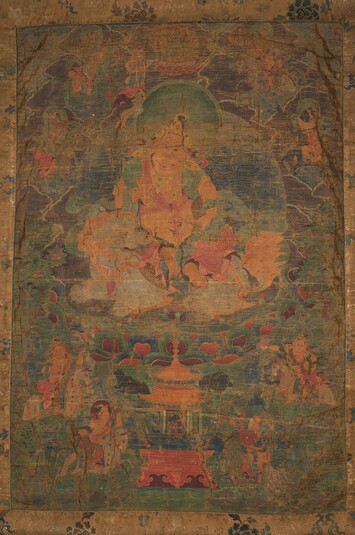
Item: Vaishravana (Buddhist Protector) - Riding a Lion
| Origin Location | Tibet |
|---|---|
| Date Range | 1600 - 1699 |
| Lineages | Buddhist |
| Material | Ground Mineral Pigment on Cotton |
| Collection | Private |
Classification: Deity
Appearance: King
Gender: Male
Vaishravana Riding a Lion (Tibetan: nam to se sengge shon. English: the Son of Nam To, Riding a Lion): the Guardian King of the Northern Direction, Lord of Yakshas - a class of Indian nature spirits. (See the Vaishravana Riding a Lion Main Page and Outline Page).
Vaishravana, with a regal bearing, has one face and two hands holding in the right a banner of variously coloured silks atop a long staff (missing). In the left, cradled against the side is a mongoose excreting gems from the mouth. The King is adorned with a jeweled crown, earrings and flowing garments of manifold colours. he sits atop a white snow lion with an orange mane and tail above a multi-coloured lotus blossom seat.
"With vajra armour, a garland of jewel ornaments and the beautiful heavenly banner - fluttering, illuminated in the middle of a hundred thousand Wealth Bestowers; homage to Vaishravana, chief among the protectors of the Teaching." (Tibetan liturgical verse).
Vaishravana, leader of the Yaksha race of nature spirits, is a worldly guardian deity, worshiped as both a protector and benefactor (wealth deity). He, with his wife - a naga princess - live on the north side of the lower slopes of Mount Meru in the Heaven of the Four Great Kings in a sumptuous palace bathed in green emerald light.
As the leader of the Four Direction Guardians, he at the head of the others, swore an oath of protection before the Buddha - Shakyamuni. Buddhist history relates how the morning after the enlightenment of Shakyamuni Buddha these Four Kings were the first to recognize the attainment and traveled to Bodhgaya, where the Buddha was residing, to make offerings to the newly Awakened One. As a group they presented the Buddha with a black begging bowl made of sapphire (or lapis lazuli). Many images of Shakyamuni Buddha depict him holding a black bowl in the left hand cradled in the lap.
The stories and iconography of the Guardian Kings of the Four Directions arise primarily from the Indian Sutra literature of Buddhism and became common to all schools and traditions of Tibetan and Chinese Buddhism. Lord Atisha, amongst other Indian teachers, popularized the meditation practice of Vaishravana Riding a Lion in Tibet in the 11th century.
There are three divisions in the study of Vaishravana iconography. The first division is Vairshravana as part of the group of Four Guardian or Direction Kings. These four are based on narrative descriptions found in the early Sutras. The second division includes all of the forms of Vaishravana as found in the Tantra literature where he is either the principal figure for meditation, or visualized in front of the Buddhist practitioner, depending on the Tantric theory and system. These forms of Vaishravana have the function of protection, wealth-bestowing or power. Vaishravana in his form known as Vaishravana Riding a Lion is the most common and most popular Tantric form of the deity - employed principally as a protector. The third classification of Vaishravana iconography is where the Four Guardian Kings are included in the larger retinue of a Tantric Mandala such as Maha Vairochana or the Seventeen Deity Green Tara.
Jeff Watt 7-2011
Buddhist Worldly Protector: Vaishravana Riding a Lion
Collection: Private 1





